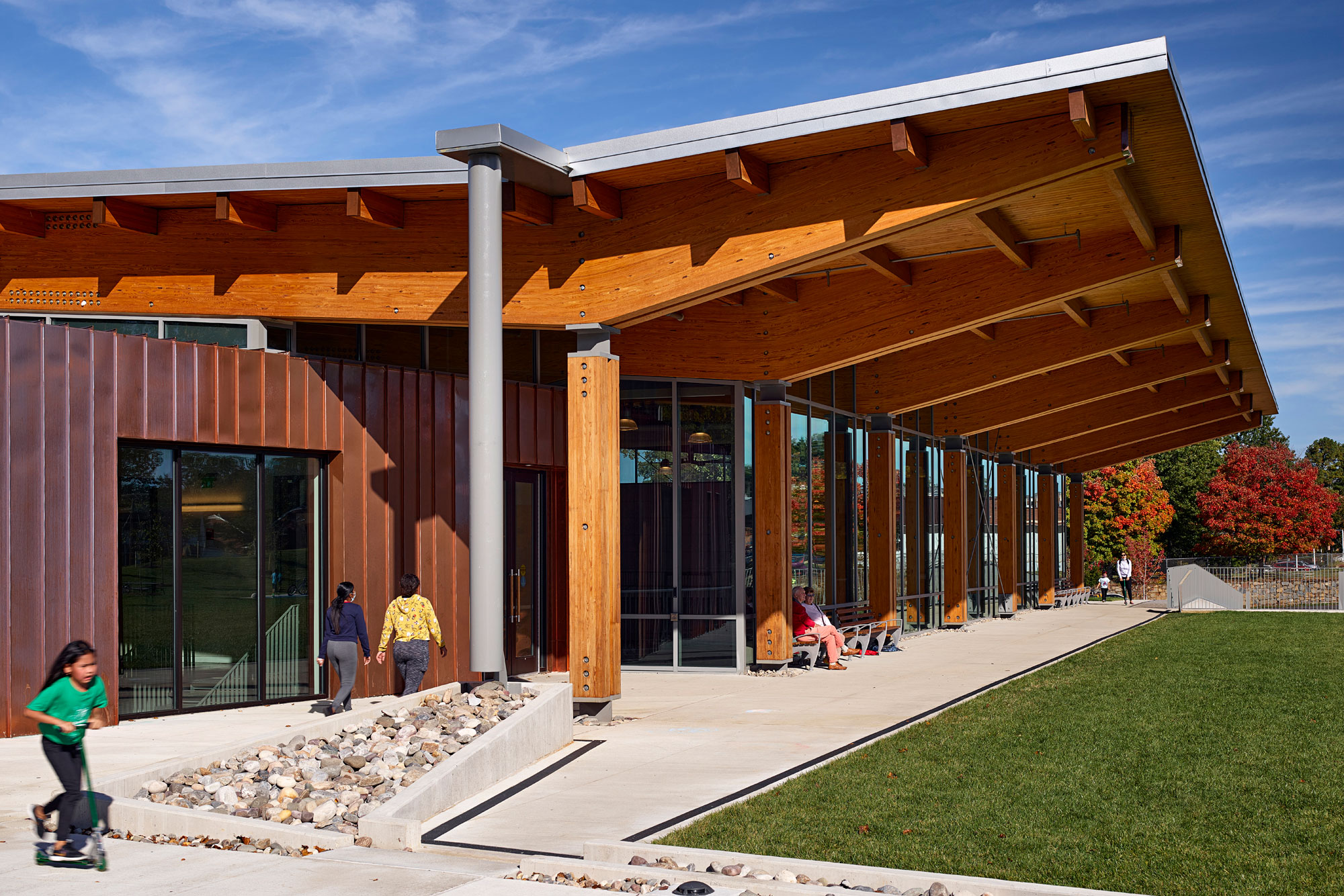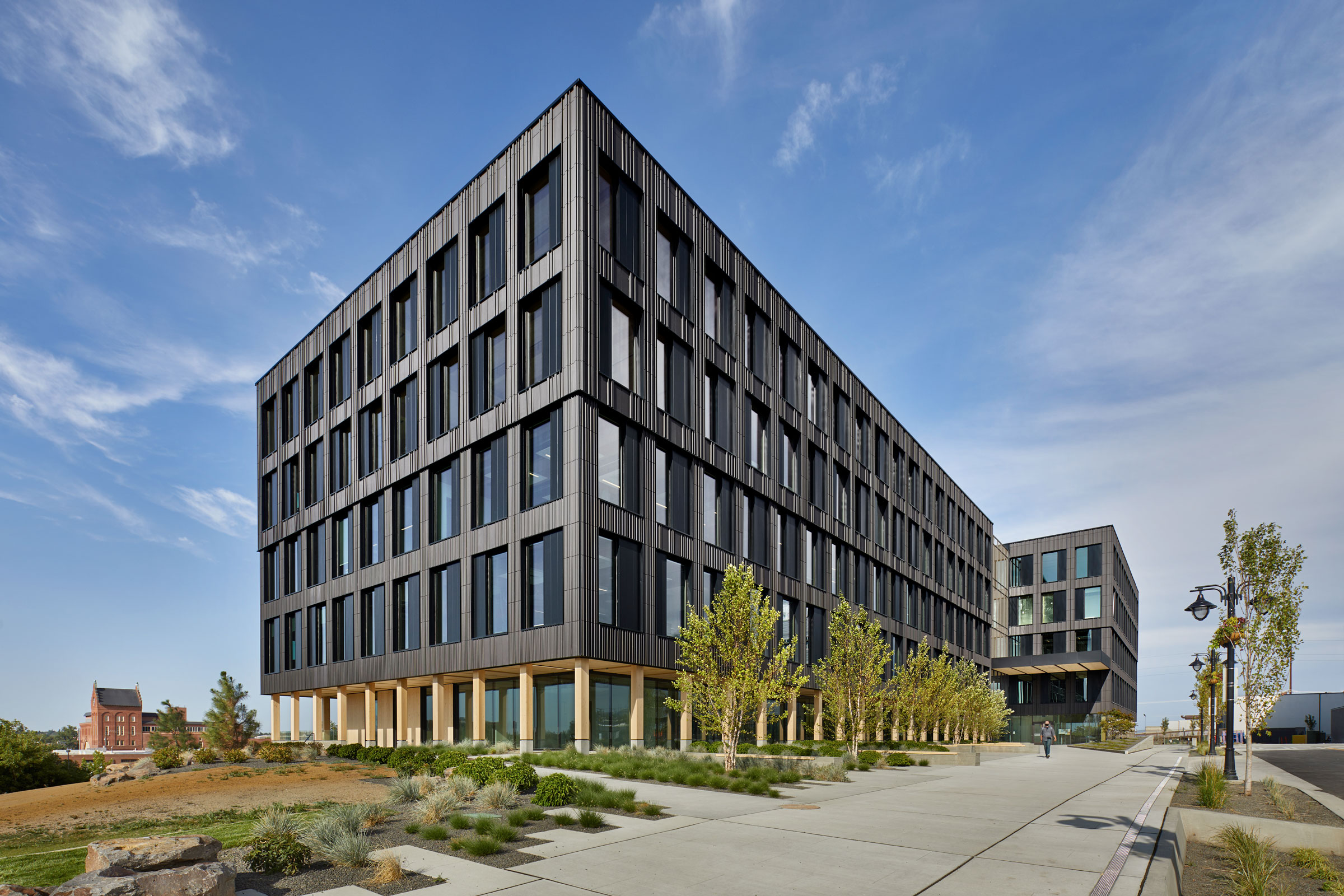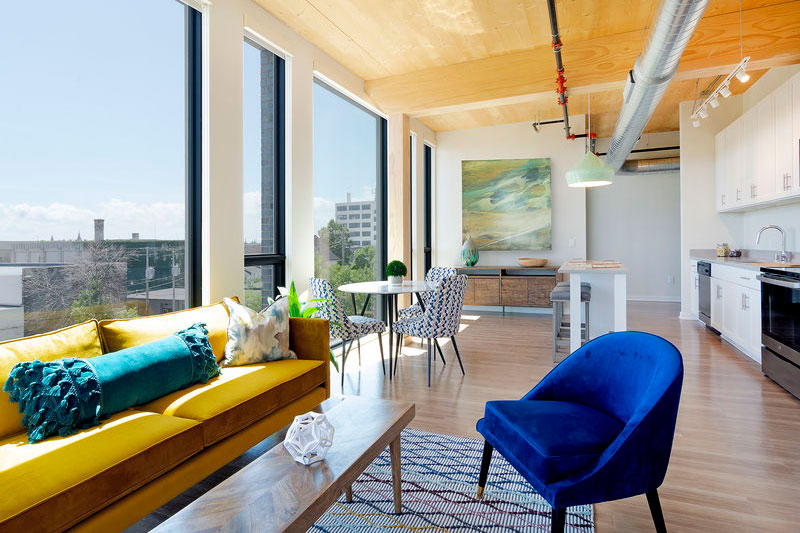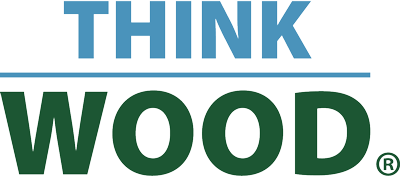As the AEC industry embarks on a new year, we look to gain insight into emerging and enduring themes that will influence the future of the built environment. What factors will shape your designs? How has the pandemic affected your outlook?
Think Wood surveyed 775 US developers, architects, contractors, and industry experts to hear their predictions for the top timber construction trends this year and to understand how the market has shifted in response to the COVID-19 pandemic.
COVID-19 Pandemic Impact ‘Remains to be Seen’
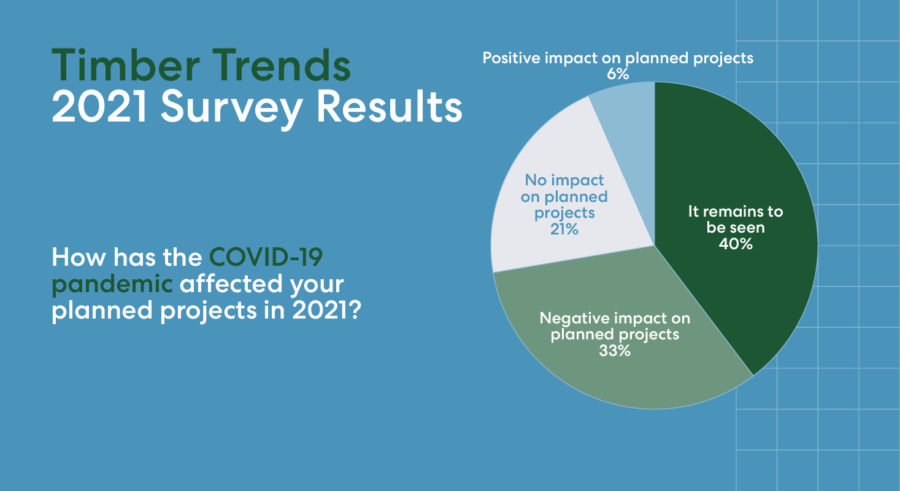
Courtesy of Think Wood
Beyond the construction delays, labor challenges, and related economic impacts of 2020, survey participants predict the repercussions of the global pandemic will persist in 2021, primarily impacting projects already in progress. The effects span construction schedules, budgets, and emerging post-pandemic design principles. Ramifications for planned projects remain to be seen.
Alongside the pandemic’s impact, survey respondents highlighted five main timber construction trends that will guide architecture in 2021.
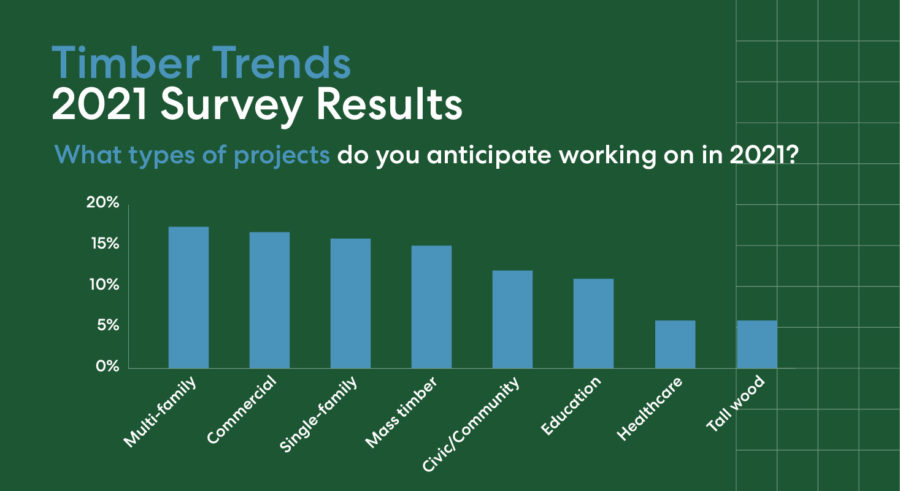
Courtesy of Think Wood
1. Addressing climate change
Survey respondents predicted low or zero carbon and green building as the top trending topic of 2021, driven in large part by industry, government, and individual firm energy and carbon reduction targets. Despite the COVID-19 pandemic, the nonresidential green buildings market reached approximately $80 billion in 2020 and is expected to reach $103 billion by 2023.
Because up to 80% of a building’s embodied carbon comes from structural materials, designers can incorporate sustainability by choosing less carbon intensive options. Wood products are one important climate solution because they require less energy to manufacture than other materials, and store carbon through the useful life of the product.
Emphasis on green building certification programs also will increase, including LEED, Green Globes, Living Building Challenge, and others. Wood products are recognized by each certification system, with LEED and Green Globes granting 8 to 10% in potential credits through substantial use of wood in construction. Tools like life cycle assessments (LCAs) also are emerging as one of the most functional assessment devices for understanding energy use and other environmental metrics, like potential to impact climate.
Low-Carbon Design: Catalyst
- Photo by Ben Scheider, courtesy of Michael Green Architecture
Anchoring the new South Landing Eco-District neighborhood in Spokane, Wash., the Catalyst building designed by Michael Green Architects and the adjacent Scott Morris Center for Energy Innovation demonstrate new building techniques, materials, and a sustainable shared energy model that makes Catalyst one of the largest zero energy buildings in North America and one of the first zero carbon buildings to be certified by the International Living Future Institute. Catalyst’s design uses roughly 4,000 cubic meters of mass timber in both structural and design elements, enabling Catalyst to achieve near-passive house levels of thermal performance, and helping to collectively offset 5,000 metric tons of carbon, equating to 1,100 cars off the road for a year.
“We believe mass timber is much more than a structural building material; it is an opportunity to guide building design and construction towards a future of sustainable building on an entirely new scale,” says Craig Curtis, former chief architect at Katerra.
2. Mass timber
Mass timber has gained major momentum in recent years. As of December 2020, Woodworks reported 1,060 mass timber projects had been constructed or were in design in all 50 states, and a new report projects that the number of mass timber buildings could double every two years. Vox further credited mass timber as “the hottest thing in architecture this century.”
Changes passed for the 2021 code cycle allow mass timber buildings to be constructed eight to 18 stories tall, signaling potential increases in overall mass timber construction in new market sectors and higher-density projects. A number of tall timber buildings are under construction in the US, and 18% of Timber Trends survey respondents anticipate working on a tall wood project this year.
Mass Timber in Action: Timber Lofts
- Photo by Roost Photography
A direct reflection of its historic-yet-trendsetting locale, Milwaukee’s first mass timber building, Timber Lofts, is an adaptive reuse project that combines a 130-year-old warehouse renovation with new CLT construction in an adjacent parcel. Architecture firm Engberg Anderson aimed to define a contemporary architectural character for the building’s new addition without distracting from the timeless aesthetic of the existing artifact. They struck a balance with mass timber, noting sustainability and aesthetics as important design factors. Mass timber also reduced their construction schedule by 20%.
“Mass timber isn’t simply a green building fad, it’s a resurgence of one of the oldest building materials used by man,” says Andrew Tsay Jacobs, AIA, EIT, director of building technology lab at Perkins+Will. The desire to use wood in commercial buildings will increase not only because it’s the more sustainable choice, but because building occupants and tenants will prefer it.”
3. Prefabrication and modular
Prefabricated and modular buildings are at the forefront of innovative construction techniques, coming in as the third most anticipated 2021 trend from survey respondents. The building industry is now embracing digital tools like 3D modeling, building information modeling (BIM), and computer numeric control (CNC) machines, making prefabrication and modular construction more common.
According to Dodge Data & Analytics, prefabrication and modular construction are providing significant improvements to costs, schedule, quality and safety performance, productivity, client satisfaction, and waste reduction. Modular construction can speed up construction by as much as 50% and cut costs by 20%, according to a 2019 report by McKinsey & Company. It also has the added benefit of being a low-carbon alternative. Design firms and contractors are forecasting expanded use of both approaches as benefits are more widely measured and the industry develops more resources to support innovative applications.
Going Modular with Model-C
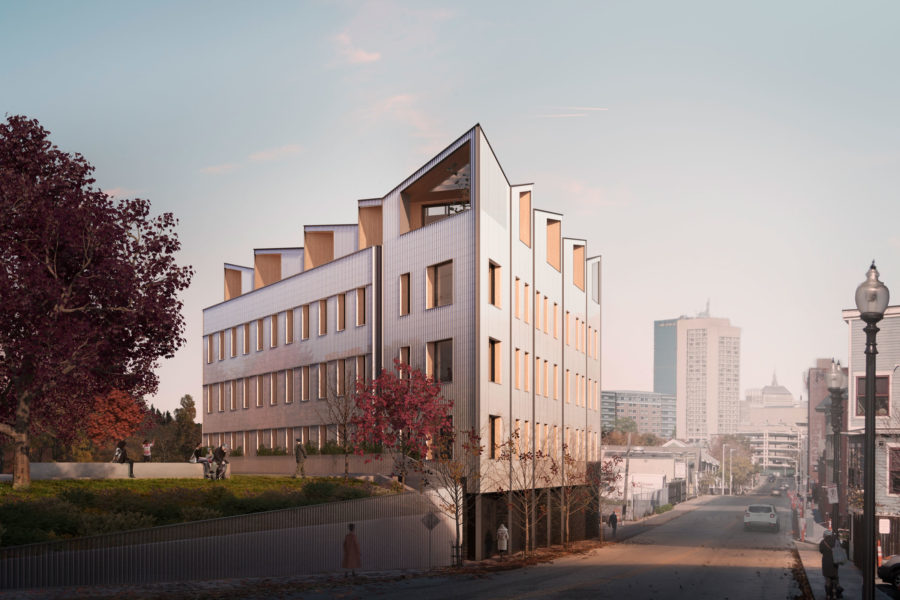
Rendering courtesy of Generate, Placetailor
The “Model-C” building system is a kit-of-parts multi-family housing assembly constructed from prefabricated CLT panels. Through demonstration projects like Model-C, MIT start-up Generate, and Boston-based design-build firm Placetailor are showcasing how wood construction can address multi-family housing shortages in dense, urban environments while meeting ambitious sustainable development goals.
Although Model-C was originally developed as an optimal system for mid-rise residential construction, its modular assembly process is designed to easily adapt to diverse site parameters and taller building applications. The Model-C building system will be delivered in prefabricated modules, reducing both construction schedules and waste. Wood construction also will maximize Model-C’s irregular urban lot, optimize solar panel orientation, and offer unique aesthetics for the building interior.
4. Hybrid construction
Building on the advantages of wood in the built environment, survey respondents predict that hybrid construction will be a major trend in 2021, both in terms of materials and construction techniques. Hybrid building, in which structures incorporate several types of structural materials, may boost digitalization, enhance sustainability, and help control budgets.
Hybrid-timber construction combines wood with materials such as steel and concrete to deliver a wide range of structural solutions. (Mass timber products often used in hybrid structures include CLT, glulam, and laminated veneer lumber.) Hybrid construction also allows architects and engineering teams to explore different materials that complement the vision of the project, while meeting many objectives that a scheme is trying to achieve, including aesthetics, thermal, and sustainability.
Lubber Run Community Center’s Mix of Materials

Photo by Tom Holsworth, courtesy of VMDO
The two-story Lubber Run Community Center structure interweaves building and landscape by literally burrowing into the surroundings of its namesake park. The 50,000 square-foot hybrid structure includes concrete, structural steel, heavy timber glulam columns, beams, and double purlins, as well as tongue and groove wood decking.
Site layout, building massing, envelope design, and systems design were driven by the zero-energy goal of maximizing the on-site solar array while optimizing the building’s efficiency. Highly efficient MEP systems and a unique Thermawall system increases the project’s energy performance while decreasing the number of building materials. Additionally, area trees felled during construction were milled to construct biophilic elements, like bench seating, for the building interior.
5. Affordable housing
According to Harvard University’s State of the Nation’s Housing 2020 report, affordable housing conditions worsened for many in 2020. Even before the pandemic-induced downturn, 37.1 million households (30.2%) spent more than 30% of their incomes on housing in 2019.
Timber plays an important role in affordable housing by improving access to economical, comfortable, and sustainable living spaces. Building techniques such as urban infills, adaptive reuse, and overbuilds are increasingly becoming a popular development approach to address densification. Adding stories to existing buildings is more feasible with timber because of its lighter weight. Multi-family housing starts increased in 2020, reaching a 30-year high of 426,000 units in the first quarter, and wood framing is used in more than 80% of multi-family buildings.
Using Wood in Richardson Apartments

Photo by Bruce Damonte, courtesy of David Baker + Partners
Designed to provide permanent residences for low-income, formerly homeless adults, this five-story project consists of 120 studio apartments. Architecture firm David Baker + Partners used wood as the primary structural material because of its relative cost savings compared with concrete and steel.
Wood was left exposed in the common areas for warmth to reinforce the sustainable philosophy of the building and provide a quality, welcoming ambiance. The spacious, secure lobby leads to a lushly landscaped central courtyard that provides a healing space for residents to gather. The facility also features wood patio furniture in the courtyard, providing additional connection with nature. The award-winning project was designed to embody the philosophy that a well-conceived building can add dignity to the lives of the people who live within its walls.
To download the full Timber Trends PDF, click here.

